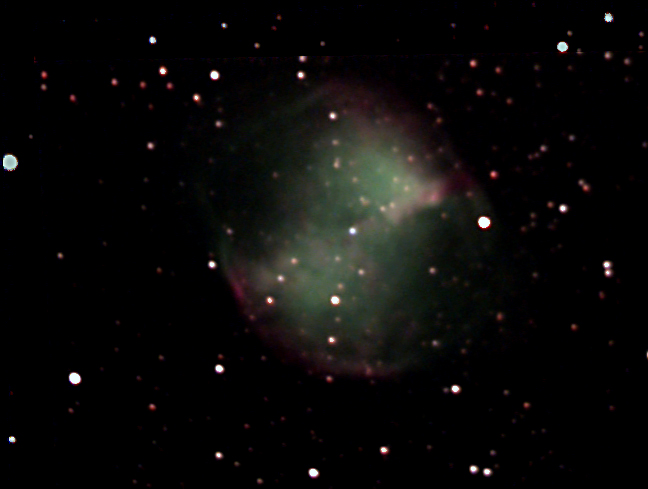
M27: Dumbbell Nebula

RA: 19hr 59min 36sec, Dec: 22º 43' 00", Mag: 8.1, Distance: 1250 light-years, Constellation: Vulpecula
This is my favourite picture of the current collection on this website. I had taken 2 previous photos of this spectacular planetary nebula in the past, but both were before I acquired the equatorial wedge and so the surrounding stars have some element of rotational smearing. This is my first attempt with the equatorial wedge. Depending on the monitor with which you view this, you may be able to see that remnant star core in the centre of the gaseous fluorescence has a blue tinge. This is the blue-dwarf core of a star which shed its outer layers when it consumed its inner mass - just as our own sun will in several billion years' time. The green is oxygen and the red is hydrogen.
This picture is the composite of 3 raw images taken with the DSI and Envisage - 20x30seconds, 3x30 and 5x25. The overall length of exposure is only just under 14 minutes. The raw images were stacked with MaximDL and the composite was saved as an 8 bit tiff file (see M20). Using Photoshop, the histogram was stretched using the Levels command in each of the R, G and B channels, keeping the stars to 255 and increasing the black level to around 20 for each of the channels. Midtones were increased differentially since histogram stretching resulted in a predominance of the red (hydrogen) colour. This was carried out using reference images of similar exposure to maintain the correct appearance of green with the red 'cross' and 'arcs' at either dumbbell ends. Gaussian blur was applied by about 75% with a radius of 1.5 pixels at a threshold of 1. I think the end result is not entirely inaccurate and is certainly pleasing to the eye!
Problems - as before, would love to deconvolve the stars.
HOME PICTURES: Deep Sky PICTURES: Solar system PICTURES: Wide field